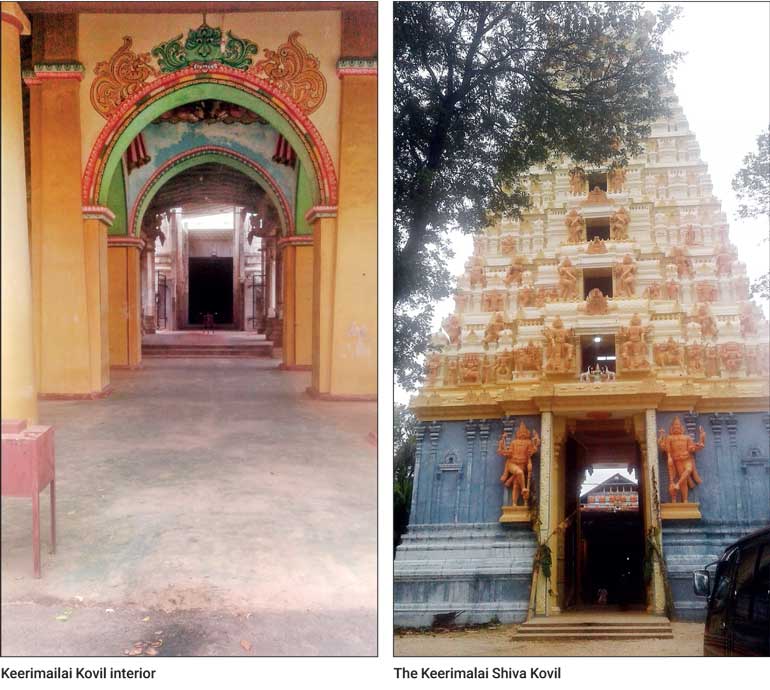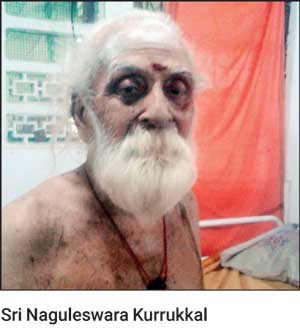Wednesday Apr 02, 2025
Wednesday Apr 02, 2025
Saturday, 26 March 2022 00:17 - - {{hitsCtrl.values.hits}}

 By Surya Vishwa
By Surya Vishwa
The ancient Keerimalai Naguleswaram Hindu Kovil in Jaffna is located within the area of Kankasanthurai, around 20 kilometres from Jaffna town, and with a history that has overcome many challenges. The chief priest in charge of this hallowed premises is as resilient. This Hindu place of worship, one of the oldest shrines dedicated to Lord Shiva in the country, has seen many facets or war and peace in modern times and survived attempts to destroy it during the colonial history of Sri Lanka.
The temple, associated with miracles from ancient times linked to the Keerimalai water fonts, has offered solace to many persons, irrespective of religion or ethnicity, says 96-year-old Sri Naguleswara Kurrukkal. Amazed at his youthful appearance I ask him if he is certain he is 96 years old! He insists he is and says that his age should be actually 97.
“I will be 97 in May, so you put down my age as 97 years old,” he chuckles.
He has met presidents, prime ministers, police chiefs, army commanders, diplomats of Sri Lanka and those of other countries, spanning over seven and a half decades where he has functioned as head of the kovil which has been owned and managed by his family for around four generations.
“I have seen Presidents come here when they are in power and out of power. Prime Ministers the same. There is one police chief who used to regularly worship here, whenever he was in the area, well before he ever thought he will be appointed to that position. I predicted that a very high promotion will take place at a particular time. And after some time, I got a call from him one night, stating that he will be arriving on such and such a date and that he will be doing so as the new police chief,” he recollects.
Naguleswara Kurukkal has witnessed the elusiveness of power. He has seen those who once travelled with their security guards and with all the pomp and pageantry arriving forlorn and alone with themselves and their karma; as normal citizens when they were stripped of all prestigious trappings. Naguleswara Kurrukkal has seen VIPs humbled to the extent of coming to seek solace from the shrine in shackles when having to spend time in jail, according to the multifarious intriguing vicissitudes that power propels. He has seen the same persons returning in exaltation to give thanks when they are reinstated in their official positions.
“This sacred place is for everyone and for me each individual is a worshipper of Shiva. I do not see people based on whatever the religion they are given in this lifetime,” he states equating God to one divine whole that can seem fragmented at times in worldly representation but which is in fact an entity of energy and an all-encompassing source.
Having spoken to him in his simple one-roomed residence at the temple premises, one sees that the only treasure he has accumulated is his spiritual wealth. A simple bed, two chairs, a table and a clothes hanger, are among the only furniture and one wonders at the sense of freedom that this Naguleswara Kurukkal must be feeling to end a life that has seen much honour, respect, fame and financial stability, with such simplicity. One wonders, how a country would be if all political leaders approached life with this wisdom and lived it with the understanding that fame and accumulated money cannot be taken to one’s grave
“See how rice is; so many varieties are there and we can make different kinds of food with it but ultimately it is rice and which can be consumed by all and provides sustenance as well as strength.”
Having taken over the responsibility of managing the shrine when he was only 22 years of age, after the demise of his father in 1947, he has learnt that the most important qualities of a spiritual leader are compassion and empathy. “A spiritual leader must conquer anger and irritation. These should be qualities of one who represents a disciplined mind and thereby who represents God.”
In his unusually long life, which is active to-date (when I visited him which was just after Mahasivarathri, I had to wait until he returned from visiting another religious place of worship), he has associated with many famous religious leaders in Sri Lanka. He cites several representatives from different religions including the Mahanayake Theros and with all he has maintained very amicable and warm friendships as is obvious in some of the experiences he shares. The humane ties he has built through the spiritual realm have far surpassed formal civility and has transcended into the genuine realm of the heart from which all peace or peacebuilding emanates.
Meanwhile, although he does not speak of the key role he played in keeping intact some humanistic sanity during the 30-year conflict that ended in May 2009, it is widely known that he achieved the herculean task of remaining neutral while focusing foremost on the wellbeing of the people.
“The army too have been in the past and still are, worshippers of this temple. Many of the officials have come to this temple with their families. I focus on the human being. In all my dealings I have focused on the empathy in every human heart,” he states and goes on to recollect an incident that occurred when the Indian Peace Keeping Force (IPKF) was in Jaffna.
“One Indian army captain came to talk to me about young boys purportedly supporting the LTTE. They rounded up a lot of youth who were mostly ordinary school-going teenagers who were sometimes compelled to carry some minor errands or meet any LTTE member when requested. The LTTE was in control of the place before the IPKF and of course if someone from this movement comes and talks to you, you cannot just run away. So, when this captain identified a whole lot of youth who were still schooling or doing their higher education and wanted me to tell him if they were LTTE or not, I told him that if these kids were LTTE then I was so too!” he chuckles.
He adds, “So I asked this Indian captain to take me away as well, stating that there have been times the LTTE had come to the temple to talk to me and where I was compelled to be civil to them. The result was that they did some thorough investigation and found that only one youth had joined the movement and that others were ordinary young people whose parents worried day in and day out about their safety.”
The manner in which he speaks, his flawless memory, alertness and his overall youthful looks makes it very hard for one to imagine he is soon to be 97 years of age. He does not wear glasses and informs me that he can see me ‘somewhat clearly’ but goes on to say that he cannot walk without some help from someone or a walker. This is the only seeming giveaway that he is ‘old.’
“Health is primarily connected with the mind. It is important that we keep the mind pure. A pure diet is also important. We should consume fresh and simple food. I have never tasted any food which is not vegetarian,” he explains.
He speaks to me in perfect English which he had been first exposed to during colonial time education and although he may not use it regularly while in his hometown, his many visits to foreign lands have accorded him the opportunity to use the language. These foreign visits have often been connected with the supervision of Hindu temples based in other countries and officiating for different Hindu festivals.
He has visited England five times including to officiate in the consecration ceremony of the London Murugan Temple. Similar honour has been bestowed on him in several other countries including Canada, Australia, South Africa and neighbouring India. Although he could have possibly easily stayed back in any of these countries, he had chosen to remain in Sri Lanka, dedicated to the task he undertook at age 22 to be committed to the maintenance of the Naguleswaram temple.
The miraculous spot on which the temple is located is believed to have been holy ground long before any structures were put up and is linked to the adjacent water source, the Keerimalai springs, believed to have curative and miraculous properties and found to have high mineral content. The origin of the temple is linked to several ancient miracles which includes a personage whose face was turned into that of a mongoose as a result of a sublime occurrence and recovering normalcy after bathing in the Keerimalai springs and praying at the ancient small shrine.
“The greatest miracle of all however is that we are all, of all of us human beings, capable of great humanity,” says Naguleswara Kurrukkal with a smile. He speaks of Sri Lanka as the one and only motherland for all its citizens. “Human beings are born and reborn to do a human duty, to honour God, to uphold purity and spirituality. There is no religious barrier to this and we all should work with the realisation that we are all One,” he reiterates.
Having spoken to him in his simple one-roomed residence at the temple premises, one sees that the only treasure he has accumulated is his spiritual wealth. A simple bed, two chairs, a table and a clothes hanger, are among the only furniture and one wonders at the sense of freedom that this Naguleswara Kurukkal must be feeling to end a life that has seen much honour, respect, fame and financial stability, with such simplicity. One wonders, how a country would be if all political leaders approached life with this wisdom and lived it with the understanding that fame and accumulated money cannot be taken to one’s grave.
He points out the salient truth; “We go to our death with nothing. Nothing can we take.” This perennial and stark truth that few of us are able to comprehend, is told with that magnanimous smile which seems like a benediction. As I leave the premises of this Hindu temple, I offer a small prayer to the person who told me about this Naguleswara Kurukkal and described him aptly as a ‘living saint.’
(The above article is part of the Harmony page initiative that commenced last year to spearhead the celebration of May as a month of peace. This year, from January onwards we conceptualised and published a series of articles that looked at peace and peacebuilding in meaningful and significant ways that is authentically representative of Sri Lanka. This series will especially unravel narratives of senior Lankans to understand their worldview.)